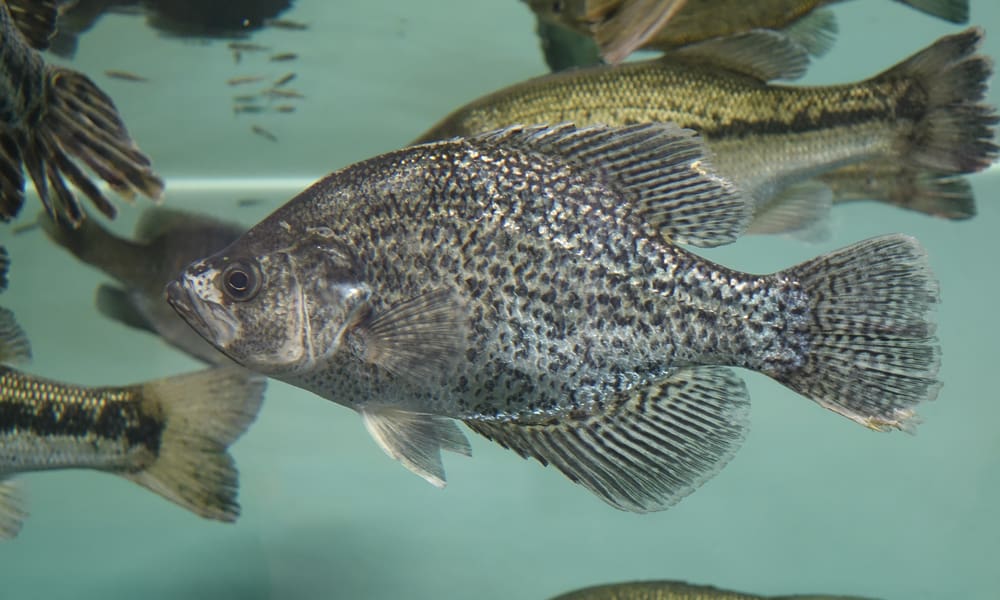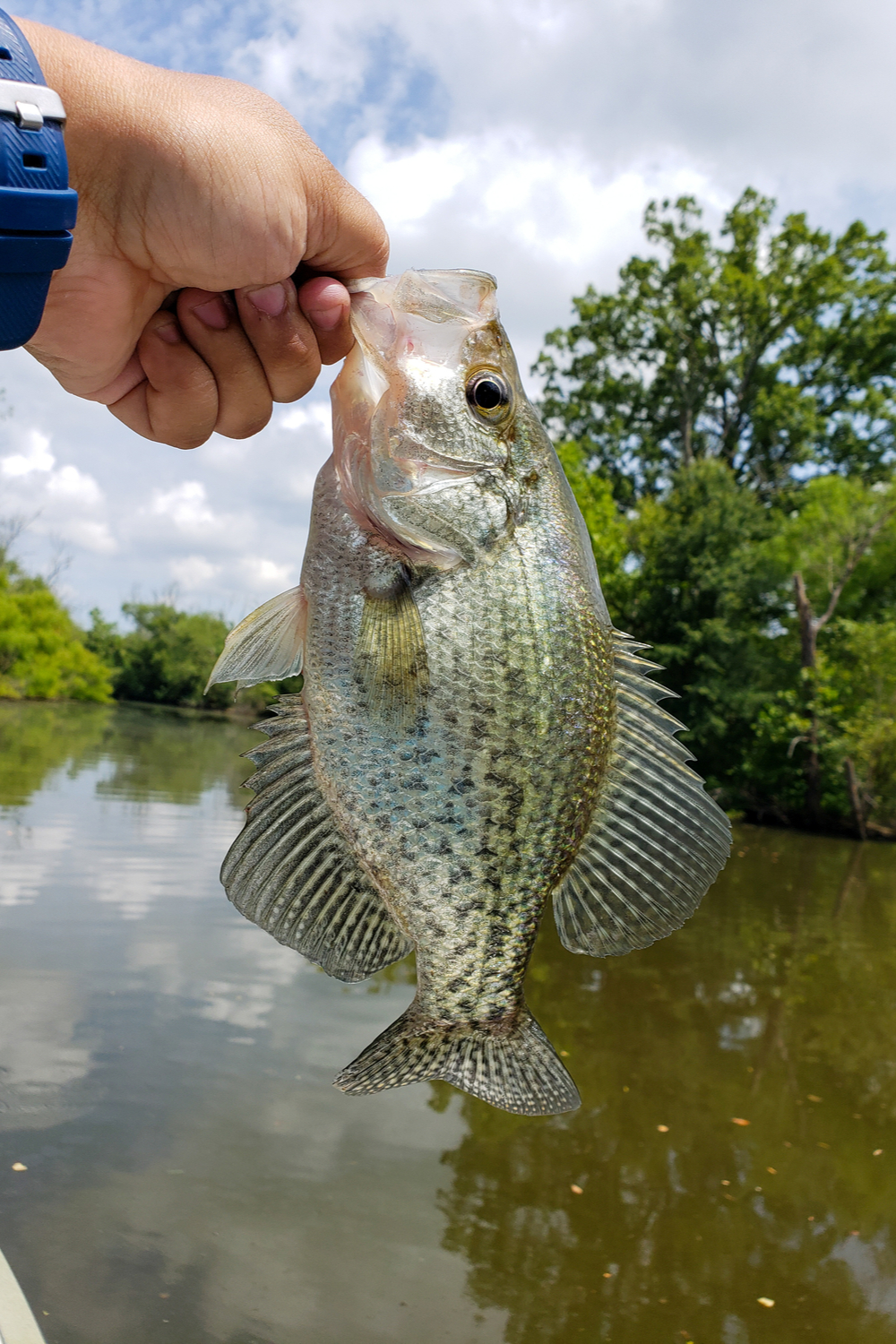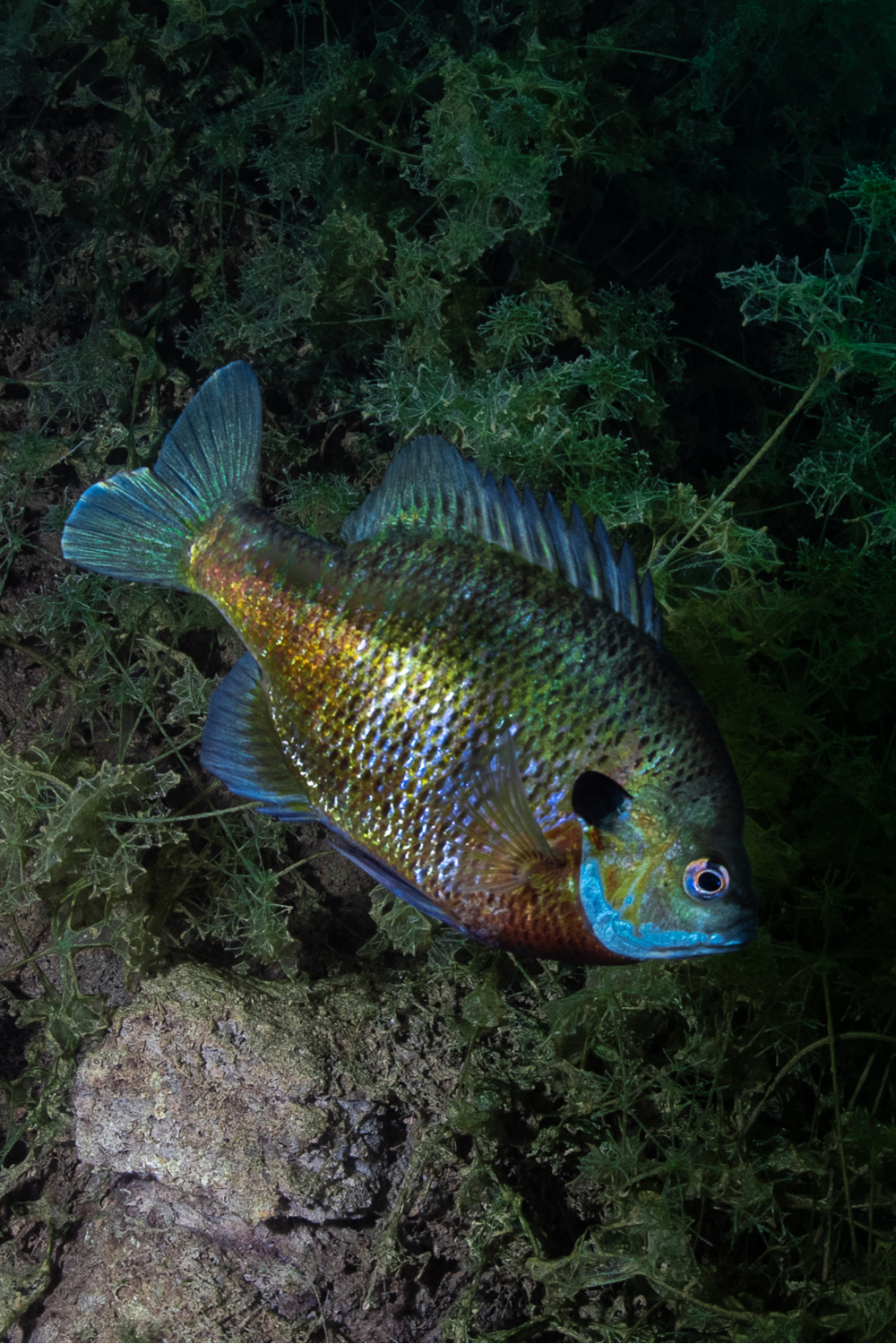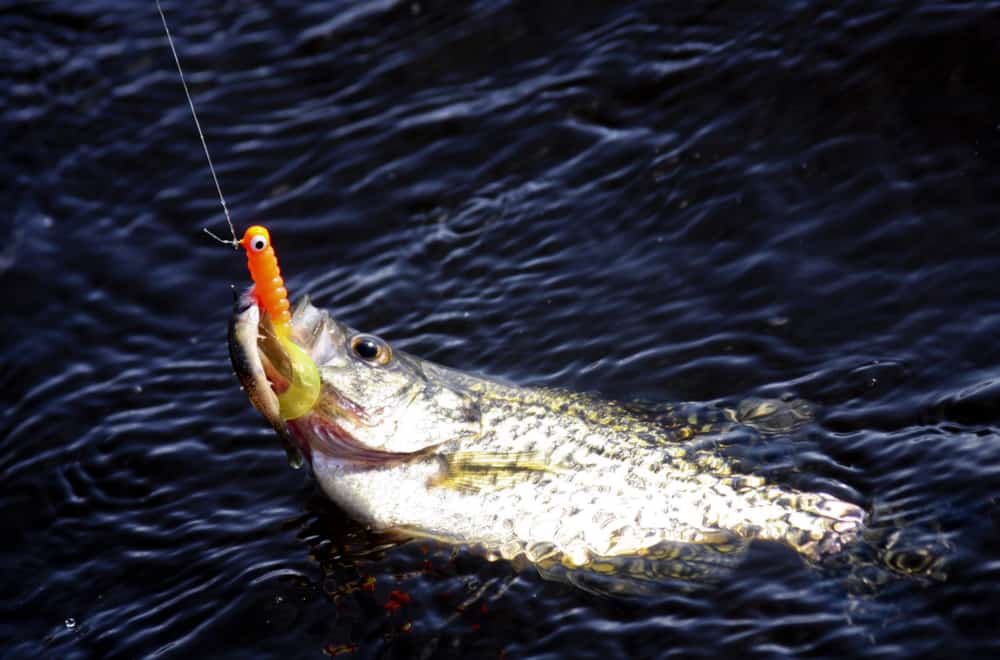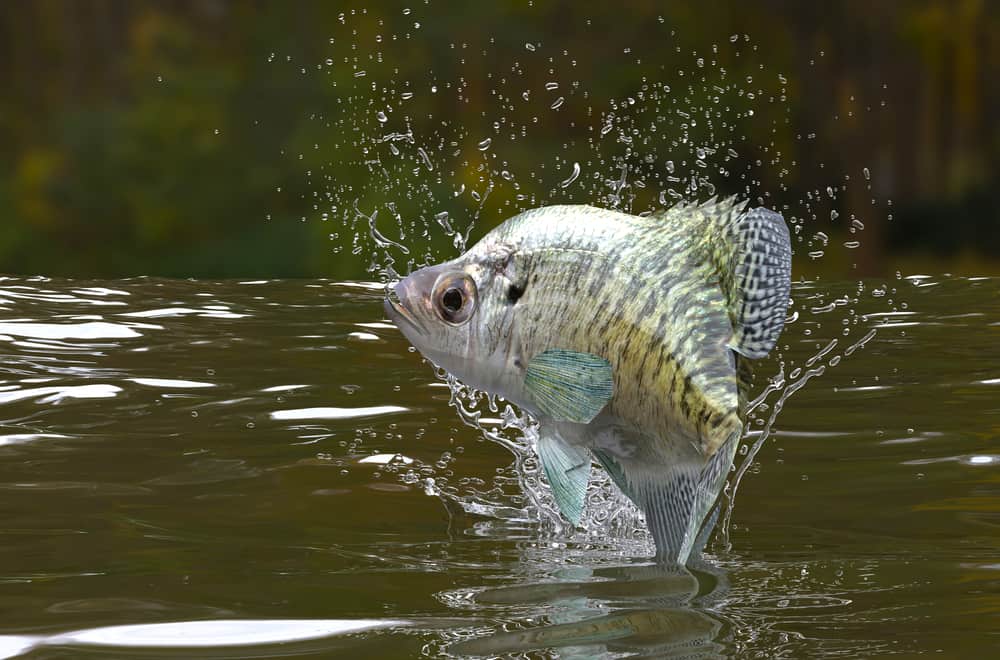While crappies are not picky eaters, they specifically like shad and minnows. However, only mature crappies will prey on these; when they are younger, crappies will mostly feed on small insects and invertebrates. This post discusses what crappies eat at different stages of their life so you can better understand their feeding habits.
Crappie Habits and Biology
Crappies are medium-sized fish native to North America. Popularly known as ‘panfish’, crappies are freshwater fish and will mostly be found in lakes and rivers. You may also find them in backwater pools hiding among vegetation or swimming in shallow water.
There are two known species of crappie fish – the white crappie and the black crappie. While these two are very similar both in appearance and distribution, white crappies are mostly found in turbulent waters while black crappies love clear waters. But sometimes both species can reside in the same habitat.
You can tell white crappies from their black cousins by looking at the patterns on their bodies. White crappies have faint vertical stripes all over their bodies while black crappies have irregular black spots. However, both species have a downturned mouth, oval-shaped body, spiny fins, and silvery-green scales.
The majority of crappies range between 10 and 11 inches in length but some grow longer. In fact, some can grow up to 19 inches long.
Crappies spawn in the spring or at the beginning of summer. During this period, the males will build a nest in the ground of the waterbody they are in by clearing out sand and mud. They will remain in these nests until the females come to mate.
The females will lay eggs in the nest and the males will release sperm to fertilize the eggs. Depending on the female’s age and size, a single fish can produce up to 40, 000 eggs.
After the eggs are fertilized, the males will remain in the nest watching over the eggs until they are hatched. The hatchlings will swim deep into the waters where they will start fending for themselves. Many juveniles are lost to erosion and predators at this stage but because crappies produce many eggs, there is still a good number of little ones that survive.
What Do Crappies Eat in Their Natural Habitat?
Crappies get their food by ambushing their prey. They do not chase their meal or roam around looking for something to eat. Instead, they sit and wait for their prey and as soon as something comes around, they use the conserved energy to strike.
The fish are most active at dusk and dawn. You will rarely find them feeding in the daytime. Nighttime, especially, is when they go to look for something to eat, and many anglers take advantage of this feeding habit to catch the fish.
Watch this video to see how crappie fish ambushes and catches its prey:
What Does Crappie Like to Eat?
Because crappies have different nutritional needs at different stages of their life cycle, what they eat will depend on what stage they are in their life, as discussed below.
Newly hatched crappie fries: Crappies start to feed almost immediately after they are hatched. They will feed on microscopic organisms like:
- Small insects such as water boatmen
- Zooplankton
- Grass shrimps
4-inch crappie fries: In the first year of eating the above foods, the young fries will tremendously increase in size and graduate to larger prey. They will start feeding on immature fish of different species like:
- Walleye
- Bluegill
- Pike
They will also feed on younger crappie fries.
Mature crappie: Adult crappies will not pass on any easy meal that comes their way. They will prey on various marine organisms like:
- Shad
- Minnows
- Insects
- Crustaceans such as crawfish
- Small amphibians such as frogs
While the above menu is what keeps crappies alive, it is important to note that it can change depending on the time of the year. For instance, during winter and the beginning of spring when food is much harder to find, crappie will revert to crustaceans and insects as their main source of food.
The diet can also vary with the species. Take black crappies, for example. Because they are attracted to clearer waters that have ample vegetation, their meals have more invertebrates than what white crappies have. But they still eat plenty of minnows.
White crappies, on the other hand, are drawn to murkier, stained water and their menu primarily includes shad and fathead minnows. While they also eat insects and crawfish, they like minnows more.
How Crappie’s Diet Benefits the Ecosystem
- One of the animals that crappie fish prey on is small frogs. Some frog species secrete a poisonous liquid that if ingested can be harmful to pets and sometimes even humans. By reducing the population of frogs, crappies help minimize the risk they may cause to humans and pets.
- Crappies are also known to eat crawfish, which helps keep the numbers of small fish high. Crawfish prey on small fish and fish eggs, which significantly reduces the fish population. They also aggressively harvest underwater plant beds, which causes the spread of unwanted marine plants.
Facts About Crappies
1. Crappies Can Live Up to 10 Years
While the average lifespan of crappie fish is around 4 years, some crappies have been found to live up to 10 years. This is in contrast with fish species of the same size, who have been found to have a maximum lifespan of 6 to 7 years.
But as with most fish species, how long crappies live will depend on their habitat. For the most part, they will tend to live much longer in protected waters. In unprotected waters, they can get overpopulated or infected with parasites, leading to a shorter lifespan.
2. Crappies Can Die in Extreme Cold
When the water is warm, say between 60° F and 70° F, crappies will often swim in shallow waters. However, when the water temperature goes below 55° F, they will move to deeper waters.
Crappies tend to live longer in warm waters than in cold waters. If the water remains below 39° F for more than one week, half of this fish species will die.
The cold temperature prevents the body of crappies to properly perform osmoregulation, causing their blood to draw excess salt from the water. This is what kills most of the fish in cold weather.
3. Crappies Ability to See Decreases with Size
Crappies are saltatory hunters. They inspect a specific area for a meal and if there is none, they move to a different area.
The hunt will be more successful if the animal they are planning to catch is located to the right or left of their head or slightly above their head. When crappies are smaller, they will be able to locate and catch their prey easily. But this ability decreases as the fish grows bigger.
Experts argue that this is a result of the angles of their eye cones getting smaller. This change makes it difficult for large-sized crappies to spot small prey, which explains why the majority eat larger prey like other fish.
4. Males Change Color and Get Aggressive During Breeding Season
During the spawning season, male crappies get darker to show the females that they are ready to mate. They will chase away any other fish that comes to their nest and even be aggressive toward the females until the females show submission and do not run away.
Once they find a mate, the two will swim into the nest together for mating where they will touch their bellies together during the egg depositing process.
5. Crappies Protect Some Organisms from Predators
Crappies have been found to host mussel larvae like muckets, threeridges, and white heelsplitters by letting them attach to their body. They also harbor leeches in their gills and juvenile fluke in their livers.
By becoming a host to these parasites, they offer them protection from predators such as white bass and walleye. Also, these parasites help regulate the population of crappies in the water, which is important in shaping the structure of the marine ecosystem.
6. Crappies Are Popular Species in Sportfishing
Crappies are often caught for sport. Recreational activities like this not only bring communities together but also increase tourism, which in turn increases the sales of fishing gear.
7. White Crappies Grow Faster than Black Crappies
White crappies are quick growers. But because black crappies are stockier, they tend to weigh more than whites of the same size. Where there is enough food, white crappies will outgrow their black relatives in just a few days.
For more facts about crappies, watch this video:
Summary
Crappies, like most fish species, feed on small marine organisms. They mostly look for their food during the night and rest during the day. Understanding crappies’ feeding habits can help any angler identify the best times to fish and what to use as bait.
